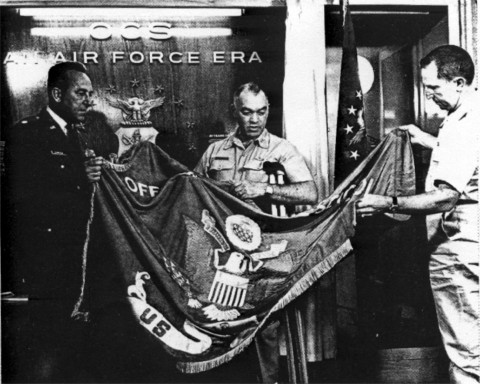OFFICER CANDIDATE SCHOOL
 With the enormous expansion of the Army Air Forces (AAF) in the early years of World War II, an increasing burden was placed on officers, especially the small group of flying officers. To ease that burden, a large number of administrative for officers had to be trained to relieve the flying officers of their non-flying duties. In. 1942 Lt. Gen. Henry H. Arnold, Chief of the AAF directed Maj. Gen. Walter R. Weaver, head of the Technical Training Command, to establish an Officer Candidate, School (OCS). In response, General Weaver quickly opened an officer candidate school in February 1942 at several Miami Beach, Florida resort hotels. Officer candidates were selected: from two categories: former aviation cadets eliminated for flying or medical deficiency, and warrant officers and enlisted men. Their, qualifications included age limits of 18 to .36, years, demonstrated capacity for leadership and a score of I10 or higher on the Army general classification test. These requirements remained in effect without major modification until after V-E Day. In succeeding years, however, these requirements changed in response to the fluctuating need for officers.
With the enormous expansion of the Army Air Forces (AAF) in the early years of World War II, an increasing burden was placed on officers, especially the small group of flying officers. To ease that burden, a large number of administrative for officers had to be trained to relieve the flying officers of their non-flying duties. In. 1942 Lt. Gen. Henry H. Arnold, Chief of the AAF directed Maj. Gen. Walter R. Weaver, head of the Technical Training Command, to establish an Officer Candidate, School (OCS). In response, General Weaver quickly opened an officer candidate school in February 1942 at several Miami Beach, Florida resort hotels. Officer candidates were selected: from two categories: former aviation cadets eliminated for flying or medical deficiency, and warrant officers and enlisted men. Their, qualifications included age limits of 18 to .36, years, demonstrated capacity for leadership and a score of I10 or higher on the Army general classification test. These requirements remained in effect without major modification until after V-E Day. In succeeding years, however, these requirements changed in response to the fluctuating need for officers.
Initially, the OCS course was 12 weeks in length and the academic curriculum was uniform for all candidates. In January 1943 the curriculum was divided into two phases. The first phase involved military indoctrination and leadership, while the second prepared candidates for duty in a particular field. To handle the expanded curriculum, officials extended the OCS course to 16 weeks in June 1943. The school remained at Miami Beach until June 1944 when it moved to the Aviation Cadet Center in San Antonio, Texas. In June 1945, only two months before it was temporarily suspended, the school moved to Maxwell Field, Alabama. During the war, over 29,000 men graduated from Officer Candidate School. After the war, the Officer Candidate School closed for a short period of time and then resumed its 16-week course in September 1945.
The following February, OCS returned to San Antonio. Although only a shell of its former self, the school continued to graduate newly commissioned reserve officers at a rate of 300-600 per year for the next 17 years, save for the Korean War when there was an increase in production. The curriculum remained substantially the same during this period although the course was extended from 16 to 24 weeks in length. There were some changes in eligibility requirements however.
When OCS reopened in 1946, only enlisted men and warrant officers were eligible. The following year, the school was open civilians, who had at least two years of college or passed a college-level test. In 1948 women also to became eligible. Then in 1952 the educational requirements for OCS were lowered. Two years of college were no longer necessary, and high school graduates could now enter. In 1955 however, OCS applicants were required to have completed one year of active duty...
In the late 1950s the Air Force also modified OCS's mission. From producing primarily administrative and other non rated officers, the school began to send about one-half of its graduates to preflight school, responding to the Air Force's need for more aircrew members. In 1959 when the Air Force, realizing that it had to expand officer procurement to meet its growing needs, opened Officer Training School (OTS), OCS's days were numbered. For over. 21 years, OCS had afforded airmen an opportunity to earn an Air Force commission. Faced with the Air Force increased emphasis on college graduates for its officer corps -and the concomitant growth of OTS, as well as the establishment. of:: the Airman Education and Commissioning Program (AECP) in 1960, OCS was phased out on 1 July 1963. During its existence, OCS produced over 41,000 officers.
*The Army Air Forces came into being on 20 June 1941. On 2 March 1942, as a result of a War Department circular and the progress of the war, it became a subordinate but autonomous arm of the US Army.
Folding the OCS flag for the last time are: Lt Col J.V. O'Brien, Commander, OCS; MajGen P. M. Spicer, Commander, Lackland Military Training Center, and Col B. H. Settles, Director of Operations at Lackland Military Training Center.

